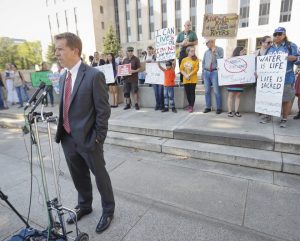Attorney Hasselman ’91 Represents Standing Rock Sioux Against Dakota Access Pipeline

Jan Hasselman ’91, a staff attorney with Earthjustice’s Northwest office in Seattle, serves as counsel for the Standing Rock Sioux tribe in their efforts to stop the construction of the Dakota Access Pipeline.
An article in The Atlantic “The Legal Case for Blocking the Dakota Access Pipeline,” asks “Did the U.S. government help destroy a major Sioux archeological site?
The article is one of several in the media that highlight the work of the legal team and the questions they raise. At this time, the issue ongoing.
Atlantic Associate Editor Robinson Meyer writes in his Sept. 9 article:
“As part of the ongoing trial, the legal team for the Standing Rock Sioux Tribe submitted documents to the court last Friday that certified one of their main claims in the case: that the pipeline will pass through and likely destroy Native burial sites and sacred places.
“These documents provided some of the first evidence that state authorities had missed major archeological discoveries in the path of the pipeline. For instance, they described a large stone feature that depicted the constellation Iyokaptan Tanka (the Big Dipper)—a sign that a major leader, likely a highly respected Chief, was buried nearby.
“‘This is one of the most significant archeological finds in North Dakota in many years,” said Tim Mentz, a Standing Rock Sioux member and a longtime Native archeologist in the Great Plains. “[Dakota Access Pipeline] consultants would have had to literally walk directly over some of these features. However, reviewing DAPL’s survey work, it appears that they did not independently survey this area but relied on a 1985 survey.”
Hasselman, who has been affiliated with Earthjustice since 1998, is working with colleagues Associate Attorney Stephanie Tsosie and Managing Attorney Patti Goldman on this project. An Earthjustice case overview offers a summary so far, updates, concerns, and a “What’s at Stake” summary: “The Army Corps’ approval of the permit allows the oil company to dig the pipeline under the Missouri River just upstream of the reservation and the Standing Rock Sioux Tribe’s drinking water supply. An oil spill at this site would constitute an existential threat to the Tribe’s culture and way of life.”
When Democracy Now reported on Sept. 7, on a federal judge ruling that construction on sacred tribal burial sites could continue. Hasselman was quoted as saying, “We’re disappointed with what happened here today. We provided evidence on Friday of sacred sites that were directly in the pipeline’s route. By Saturday morning, those sites had been destroyed. And we saw things happening out at Standing Rock—dogs being put on protesters—that haven’t been seen in America in 40, 50 years.”
Hasselman, who majored in history at Wesleyan, is a graduate of Boston College Law School, where he was was executive editor of the Boston College Environmental Affairs Law Review. While at Earthjustice, he has successfully litigated a number of regional and national issues, including listings of salmon under the Endangered Species Act, stormwater pollution, coal fired power plants, and forestry. He also serves on as an adjunct on the faculty of University of Washington and Seattle University law schools.

